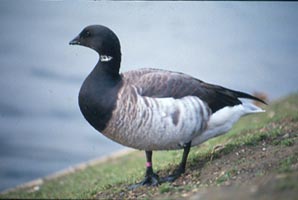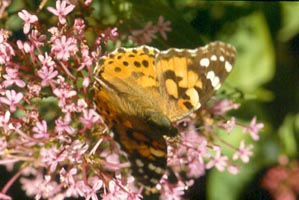On
an early morning in June I was bringing the dog into the woodland of Killiney
Hill at a spot where a tall Larch tree lies fallen across the path. There
was something perched on top of this fallen tree and as I approached it I
still could not make out what it was. It was an odd mix of black and bright
shiny colours which suggested a discarded item of clothes seemed to be the
most likely explanation although it still seemed to have a strangely animal-like
shape. The dog could not figure out what it was either and approached it
very cautiously. Then I saw it was a cat. It was sitting motionless on the
log with a popcorn bag wedged over its head down to its shoulders. For a
moment I thought it might be dead, a brutal act of senseless violence against
a small creature, then I saw it was tensing up at the dog’s - by now
- frantic barking. Much more likely was the cat had put its head into the
bag perhaps squeezing down into it after the salt at the bottom of the bag
and had got stuck! Anyhow, although I am not a big cat fan due to their senseless
predation on birds and small animals, I couldn’t leave it there defenceless
and reached down to take the bag off its head. I needn’t have worried
about its defencelessness though. As soon as I touched the bag the cat jumped
about a foot off the log lashing out a paw and ripping about ten long scratches
into my hand before - now the bag was well gone - racing up the nearest tree.
I continued my walk with blood flowing freely from my hand and only too glad
to recount my experience to anyone who might ask. The cat seemed no worse
for its experience.
It just shows what a threat discarded litter can be to wildlife. Some of
the worst damage is caused in the sea where, apart from miles of discarded
fishing nets, thousands of tons of plastic in various forms can float around
for years before being swallowed by fish or turtles. Plastic bags, having
the same shape in the water as jellyfish, which form a major part of the
turtles’ diet, cause the turtles to often swallow them with the result
frequently being a lingering death because the plastic bag doesn’t
degrade in their stomachs. Discarded fishing lines and hooks cause death
to fish and birds long after they have been discarded by their human users.
Earlier this year there was a Red Throated Diver in Dun Laoghaire Harbour
wrapped in fishing line which would ultimately restrict the bird’s
ability to fish but left it mobile enough to escape anybody trying to help
it. The plastic rings that hold six pack cans of beer together are a perfect
size for getting stuck around the necks of animals, birds and fish. I always
try to follow the example of a friend who always tore these plastic rings
apart so wherever they end up they can’t do any further damage. Fulmars
and Albatrosses are very prone to accidentally ingesting plastic, being surface
feeders who only have a fleeting moment to see and scoop up food from the
waters surface. A small bit of red plastic could easily be mistaken for a
piece of gutted fish. A Fulmar found dead in the US was found to contain
59 pieces of plastic! The variously shaped indigestible pieces of plastic
would have eventually blocked the bird’s gut possibly causing it to
weaken and die.
A retired oceanographer in the States, Curt Ebbesmeyer, has become an expert
on the rubbish that pollutes the world’s oceans. He was able to deduce
that a piece of plastic marked “VP-101” found in the stomach
of a dead albatross chick along with cigarette lighters, bottle caps and
hundreds of other pieces of plastic, was likely to be a Bakelite tag for
a U.S. Navy patrol squadron during World War II, and could, indeed, have
floated in the ocean for 60 years before the albatross swallowed it. It’s
estimated thousands of containers get lost overboard from ships every year
and their contents can be floating around the oceans for years. With computer
programmes Ebbesmeyer and his colleagues can accurately predict where currents
can carry man-made debris from such spills including hockey gloves from a
container that spilled 34,000 of them; Nike tennis shoes and trainers from
container spills between 1990 and 2003 (currents carried the lefts to certain
beaches, the rights to other shores!) and 29,000 'First Years’ bathtub
toys consisting of yellow ducks, blue turtles, green frogs and red beavers.
As individuals there isn’t much we can do about it apart from picking
up any rubbish we find on the
beach and it’s a depressing thought how much harm we’ve already
done to the planet.
LATE
ARRIVALS EARLY DEPARTURES
In early August, if the weather has been good, the skies can often resound
to the high pitched screeching calls of tightly bunched groups of Swifts
hurtling over the rooftops hunting insects in the warm air. These are family
groups of these lovely little birds and sadly most of them will be gone by
mid-August already migrating south. Their total reliance on high flying insects
which only rise in the warm air means they need warm weather so our latest
arriving migrant is our first to depart.
THE STURDY ELM TREE
There are a few different species of Elm tree but the Elm’s main claim
to fame is sadly because of their susceptibility to Dutch Elm disease which
devastated elms in the UK and Ireland during the 1970’s. Elms were
more a feature of the English countryside then here where their tall native
English Elms were a prominent feature of hedgerows on farmland. Dutch Elm
disease, whose name originates from Holland where it was first identified,
is caused by a beetle whose presence in the tree ultimately creates a fungus
which prevents the sap rising up the bark and the tree effectively starves
leaving the trees with peeling bark on dead trunks and a few suckers growing
out of the base. The only way to combat the disease was to cut down the remaining
trunk and burn the infected timber. Thousands of elms disappeared from the
English countryside and the situation was mirrored here to a lesser extent.
Many trees here were left alone after they caught the disease and after initial
damage, many of the trees held on to a glimmer of life and after a while
shoots regrew from the base. The Dutch Elm disease beetle can recur after
nine years but many trees here have made a substantial recovery. Ireland’s
native elm is the Wych Elm and thankfully this tree isn’t as susceptible
to the disease. I’m not 100% certain which species - the English or
Wych - is growing in the grounds of the Church of the Assumption in Dalkey
opposite St. Begnet’s Graveyard, but it’s a splendid healthy
looking specimen. Many English elm have regenerated themselves on Dalkey
and Killiney hills in the park and I’ve even had one appear in my garden
almost certainly planted by a bird passing the seed through its digestive
system. Flowers appear on the trees in early spring soon turning into seeds
which fall before the leaves appear. These seeds are evidently a very nutritious
food source very popular with Bullfinches and for the last two years I’ve
seen Red Squirrels feeding on them on Killiney Hill. A lady in the Britain
actually has a theory that the Red Squirrels disappearance before the ever
expanding population of Grey Squirrels is partly due to the loss of the elm
seeds as a food source. Elms, although sometimes in the past very frail and
unhealthy looking, are living proof of that old adage that where there’s
life there’s hope.
|



